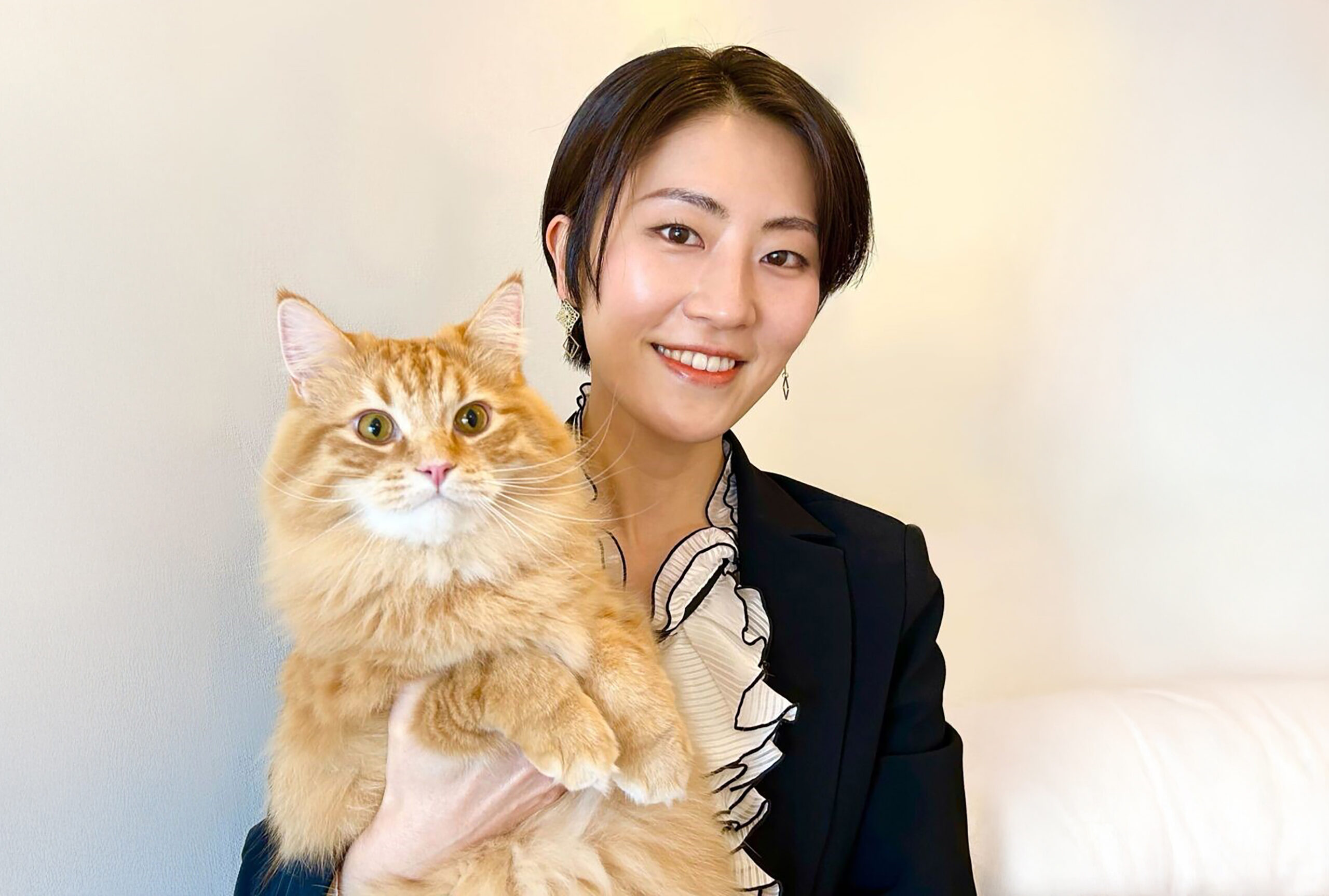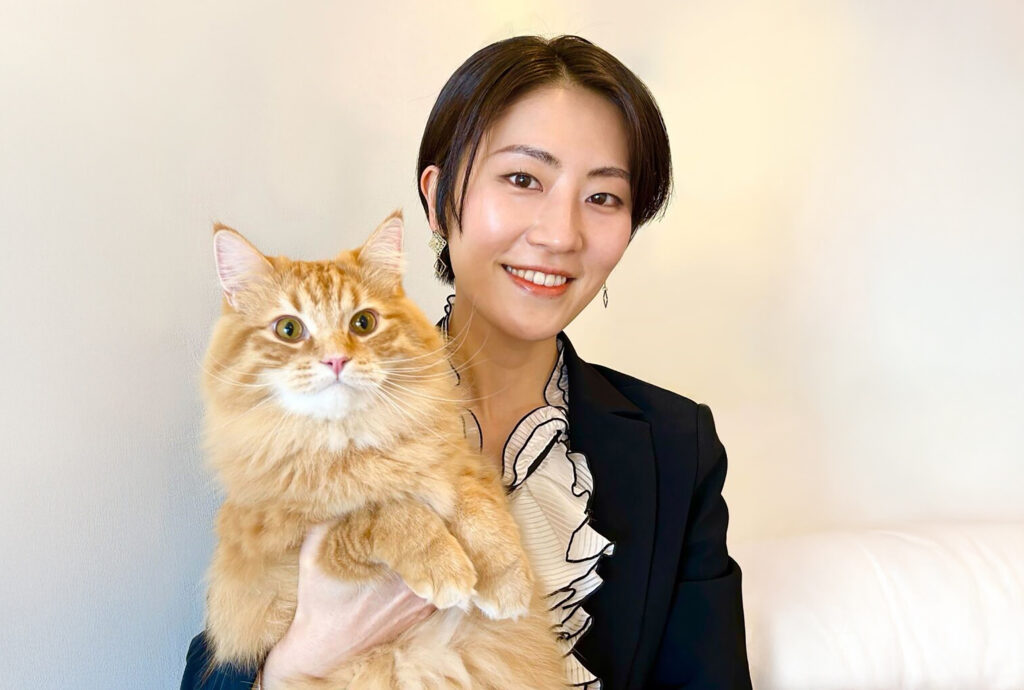
Interview with Nihonga artist Maria Mizoguchi by art consultant Takashi Watari. Maria will hold a solo exhibition at the Isetan Urawa store in Saitama City starting December 31, 2024. Please enjoy!
Related article: Interview with Nihonga artist, Maria Mizoguchi
Interview with Nihonga artist, Maria Mizoguchi; “I want to live to be 120 and continue to paint!”
I want this exhibition to invite good fortune in the New Year
You’ll have a solo exhibition from December 31st over the New Year, at the Isetan Urawa store in Saitama. This past October, you held a trio exhibition in the same space with Rina Hasegawa and Hiromi Torimoto.
In the October exhibition, I created paintings with various motifs that included ones from Turkey, where I traveled earlier this year. The upcoming exhibition is titled “New Year, Fuku Maneki (bringing in good luck)”. Since the exhibition is from the end of the year to the beginning of the New Year period, I will create pieces that invite good fortune. I plan to exhibit many auspicious-themed pieces featuring maneki neko (beckoning cats) and the Chinese zodiac.
I’m in the middle of creating 6 pieces simultaneously. I plan to bring about 40 pieces in total, including new works and works I have on hand. I will be bringing many paintings of cats. The cats I usually draw are cool and slim, but since these cats are inviting good fortune for the New Year, I’m drawing them as plump figures powerfully exorcising evil spirits in order for the paintings to feel more auspicious.
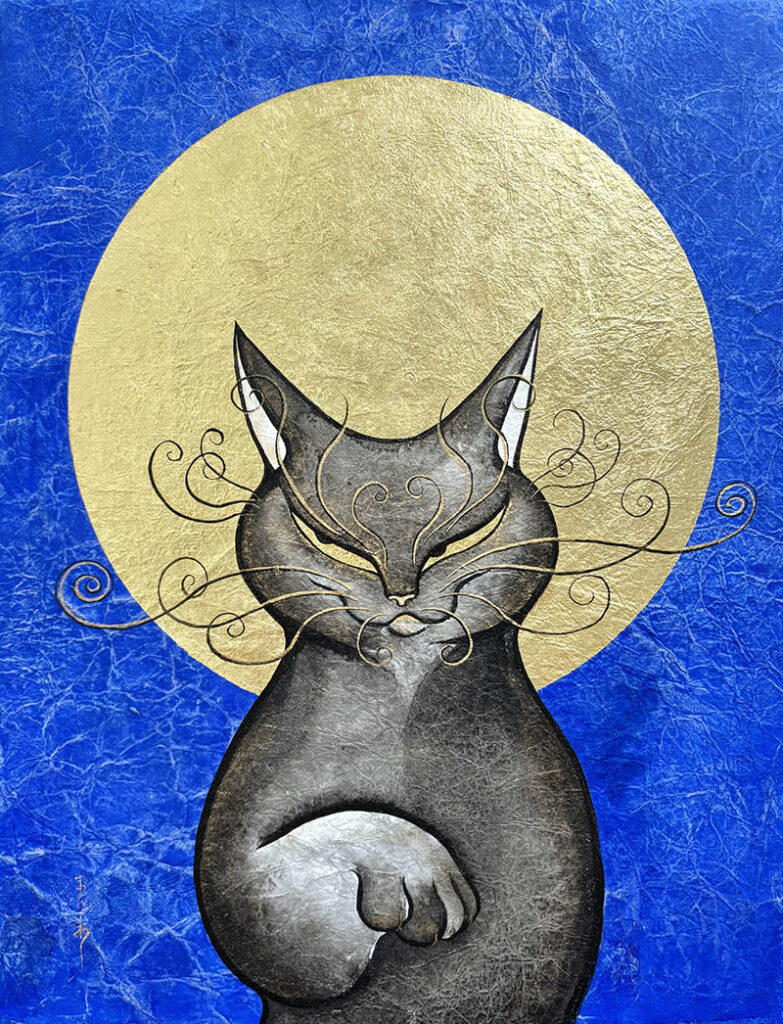
These cats are different from those you’ve drawn in the past.
In the work Fuku Maneki, the cat’s gaze isn’t looking at the past, but rather to the future. The direction of the cat’s eyes implies that a good future will be brought in.
Are your cats Raiden and Kintoki, the models for this painting?
The painting is a mixture of the three; Raiden, Kintoki, and their predecessor, Ryu. The cats often enjoy themselves, but the image of the painted cat will not miss even the smallest evil spirit coming its way.
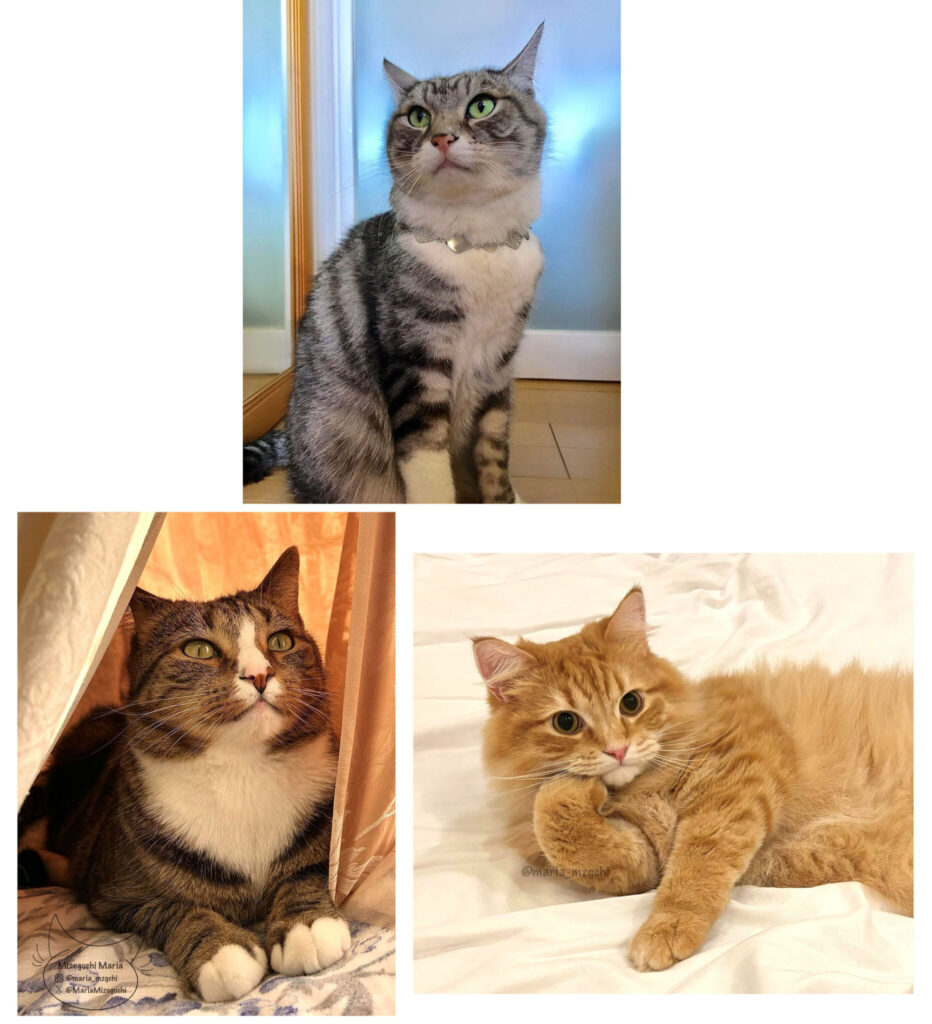
bottom left: Raiden
bottom right: Kintoki
Each cat, with their unique personality, inspires Mizoguchi’s creations.
I had a hard time deciding how to draw the Chinese zodiac snake.
You mentioned the Chinese zodiac earlier, and next year is the year of the snake. Does that mean you will also draw snakes?
Yes, I plan to have paintings of the year of the snake in this collection. Even though many of my paintings are of cats, I enjoy painting other animals. Before cats, I used to work on various paintings including portraits, landscapes, flowers, and fish. I particularly liked painting reptiles. Snakes, my personal favorite, are auspicious creatures, but they’re a difficult theme for a painting on a wall. Since the beginning of this year, I’ve been experimenting to see what kind of snake drawings would look good in a home and invite good fortune. I can finally show you the finished product.
I’m looking forward to seeing what kind of snakes you’ve come up with. Have you been doing research on them?
For this collection, the focus is on snakes as creatures inviting good fortune instead of being scary. As for doing research, I’ve always loved visiting the zoo, so I visited the Vivarium exhibit and the Reptile and Amphibian House area at the Ueno Zoo.
You mentioned that you are a pet enthusiast, not just for cats, but for a wide range of animals. Besides Raiden and Kintoki, do you have any other animals living with you?
I have an elderly Shih Tzu, Lily. She’s very astute and keeps her distance from the cats to avoid any conflicts. When the cats start running around, Lily senses that she might get caught in the middle and quickly moves away. That said, she sometimes curls up with the cats at night and sleeps next to them, so they all get along quite well.

Have you painted dogs?
Yes, I have painted dogs in the past. However, when I was a freshman, I found that cats always became the subject of my paintings whenever I reached a small turning point in my life. They have since become the main focus of my work. It was also cats that led me to be selected for art competitions and to find my way in life as a painter. I have painted many different things, but I’ve decided to concentrate on cats and create works surrounding that theme, so now I paint mainly cats. Still, I love all living things in general, so when I feel like drawing something other than cats, I will do so as well.
Cats were also the theme of your paintings in the process of making your artist debut, and being selected for the Mitsubishi Corporation Art Gate Program. After that, your cat paintings were selected for the Nitten and Nisshunten (Spring Exhibition of the Japanese Painting Division of the Nitten), group exhibitions. Is there a reason why you don’t belong to a particular exhibition group?
It honestly never occurred to me. When I set my goal to live as a painter, I never thought about belonging to an art group. Recently, one of my senior artist friends found themselves in a position to serve as a judge for their group organization, and it’s been a refreshing revelation for me to discover that way of life. I would not be where I am today as a painter without the help of everyone who has supported me.
The awe-inspiring sense I felt at seeing Gunkei-zu (Fowls) by Ito Jakuchu, was the catalyst for becoming an artist.
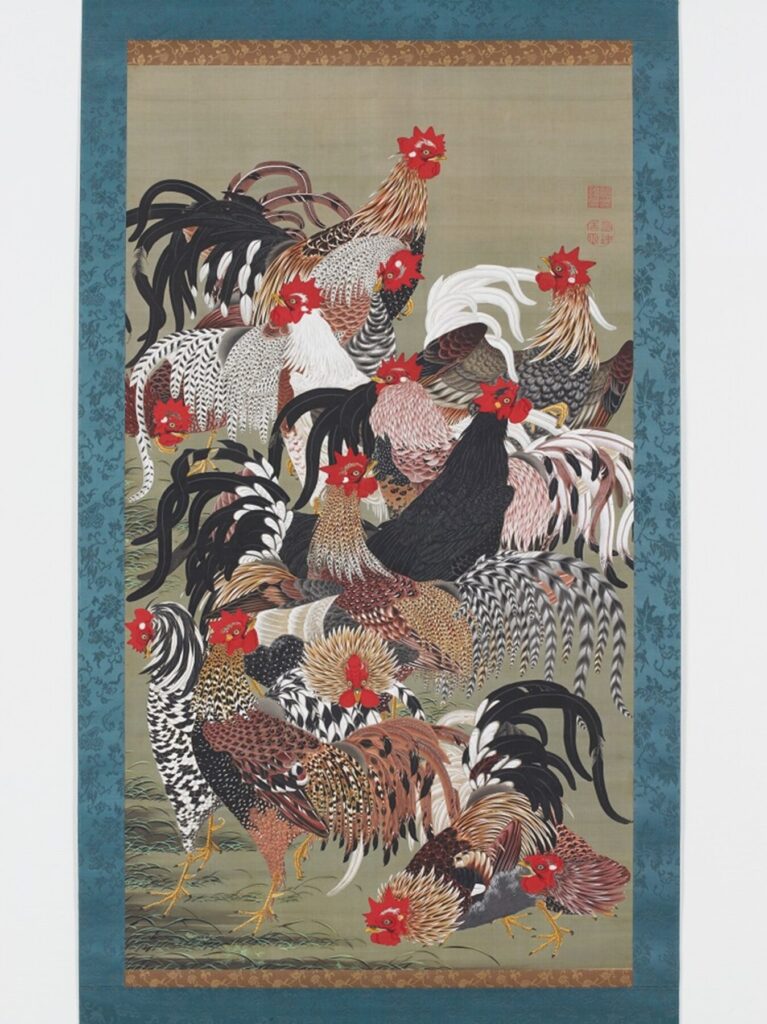
Before 1765 (Meiwa 2) Collection: Imperial Palace, San-no-maru Shōzōkan Source: ColBase (https://colbase.nich.go.jp/)
Of all the paintings in the world, this one determined the direction of Maria Mizoguchi’s life.
I recall that in past solo exhibitions, in addition to cats, you also had yatagarasu (mythical three-legged crow), chickens, and owls in your collection. You mentioned in a previous interview that you were inspired by the works of Ito Jakuchu.
As a high school junior, I had the opportunity to see Ito Jakuchu’s Gunkei-zu (Fowls) in person. I was speechless and moved to tears. That was the catalyst for my decision to become a Nihonga artist. My painting style and expression are vastly different, but I want to paint works like Jakuchu — ones that allow you to feel the power, the breath, and the energy of living creatures. I think I have inherited his spirit.
That’s the part of Jakuchu that drew you in.
Yes. I deeply appreciate the realism of his paintings, but more than that, I feel his deep love and respect for the subject of the painting. I think that Jakuchu composes his paintings in a way that brings out the best in the creature or the subject. At first glance, his paintings may look realistic, but actually, the drawings are distorted. I think that’s one aspect of Jakuchu’s work I’ve been influenced by.
Have you been to see Jakuchu’s paintings since your initial encounter?
Yes, I particularly remember “The Price Collection: Jakuchu and Edo Paintings” exhibition at the Tokyo National Museum in 2006, and I often visit other exhibitions where his paintings are on display.
Has your view of Jakuchu changed after having seen his other paintings since launching your career as a painter?
I am moved every time I see Jakuchu’s paintings, and I almost get a sense that this deep emotion is one I will feel within myself eternally. Whenever I look at his paintings, his subjects seem so full of life. I also want to create works that feel fresh and vibrant every time I see them.
Seeing Hokusai’s masterpieces, I vowed to continue painting until I’m 120!
You recently painted a piece that pays homage to Hokusai, how did that come about?
In March of 2024, I was asked to participate in an exhibition that will pay homage to Hokusai. I’d never done any homage painting before, so I thought about how I, as a modern-day painter, would create a painting that expresses the greatest respect for Hokusai.
First, I went to the Sumida Hokusai Museum to do some research. I saw his paintings and got books to find out more about him and the changes in his artistic style throughout his life. In his day, Ukiyoe prints were created through a division of labor among specialized craftsmen such as engravers and printers. I wanted to take that concept and imagine how this group of people would express printmaking today.
Those craftsmen began by using a blue pigment called Bero Ai (also known as Berlin or Prussian blue), which had just been introduced into Japan. Even with the differences between printmaking and Nihonga, the craftsmen incorporated Bero Ai, the most cutting-edge blue back in the day. I decided to pay homage by using the cutting-edge blue of our time, the YInMn Blue*. I think that taking on the challenge of incorporating cutting-edge painting materials into a traditional field is a form of respect.
*YInMn Blue, also known as Oregon Blue or Mas Blue, is an artificial blue pigment discovered by chance by a science team at Oregon State University while researching new raw materials for use in electrical systems.
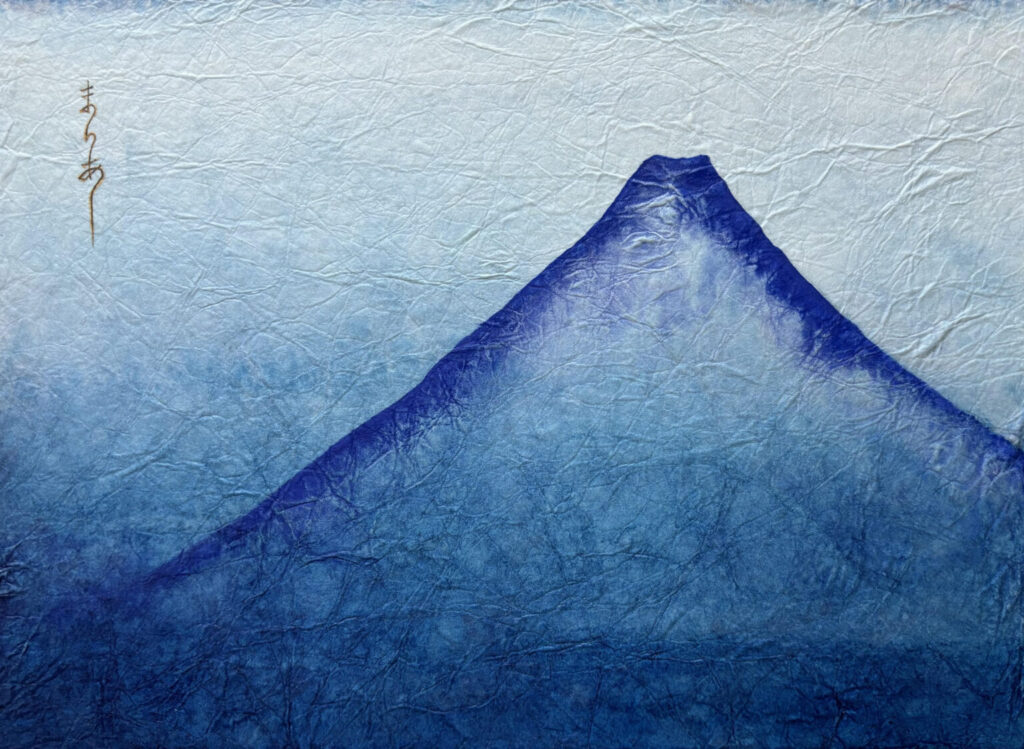
Katsushika Hokusai’s Gaifu Kaisei (South Wind, Clear Sky) is famous as Red Fuji, but there is an indigo print using the same plate. Mizoguchi, who is particular about blue, chose Blue Fuji. The background is painted in a gradation of colors by layering the Bero Ai using the tarashikomi technique, while the vivid YInMn Blue is used on Mt. Fuji. The use of Momi-gami (intentionally wrinkled paper) gives the painting a richly nuanced surface that brings out the texture of the washi.
Hokusai’s masterpiece Fugaku Sanjurokkei (Thirty-six Views of Mount Fuji) was not painted until much later in his life.
That’s right, he painted his masterpiece after the age of 70. His expression and shaping of the waves evolved with age. When I think about the time it took Hokusai to finally arrive at the expression of the claw-like waves attacking the subject in Kanagawa Oki Nami Ura, I wonder if it would be respectful for me to borrow just that result. Even so, with utmost respect, I gave it my all. It was my first time to work in this genre, and it was an incredible learning experience. I feel that it has allowed me to develop more as a painter and an artist.
There are many other Hokusai works, such as the Hokusai Manga and a series of drawings of monsters, but this time you chose Fugaku Sanjurokkei (Thirty-six Views of Mount Fuji).
From Fugaku Sanjurokkei (Thirty-six Views of Mount Fuji), I worked on paintings paying homage to three of Hokusai’s works: two blue prints of Kanagawa Oki Nami Ura and Gaifu Kaisei (South Wind, Clear Sky) and his iconic hand-painted Fuji Koshi Ryu (Dragon flying over Mt. Fuji).
Were those three the most meaningful to you?
Yes. Even though what I saw was just a replica of the Fuji Koshi Ryu (Dragon Flying Over Mt. Fuji), I couldn’t get it out of my mind. It is said to be the last piece Hokusai painted in his life. When I saw the dragon desperately rising above Mt. Fuji, opening all its claws and ascending to the heavens, I strongly felt that if Hokusai had lived, he would have continued to change and evolve his painting style.
You felt that Hokusai’s way of life was inspiring. There was a time when Hokusai himself used the signature Gakyou Roujin Manji (old man mad about art), which indicates that he really loved painting and kept on painting because he couldn’t help but love it.
Yes, I have the feeling that he would have liked to have painted more, had he lived. I recently turned 32 on November 25th, and I intend to live and paint until I’m 120. I have renewed my desire to paint with all my might for the rest of my life!
Wait, why 120?
When I saw Ito Jakuchu’s Gunkei-zu, it gave me a goal to become a Nihonga painter. When I was 20 years old I asked myself one question, “How can I create a painting that moves me so deeply that my soul shakes?” My answer was to “Live another 100 years and keep painting!” I thought maybe, just maybe, if I work hard for 100 years, I may someday be able to create a work of art that will be inspiring and passed on to future generations. I hope to continue painting until the day I live out my natural life. …… Every year I vow to myself to do my best for another 100 years, so my life expectancy must be increasing!
This means that you will live beyond the ages of both Tamako Kataoka, who lived to be 103 years old, and Yuki Ogura, who lived to be 105 years old!
Fumiko Hori, who was my senior at Joshibi University of Art and Design, lived to be 100 years old. I once saw an exhibition of her work at the Omura Museum of Art in Nirasaki, Yamanashi. I truly admired her style of traveling to foreign countries and painting based on what she experienced and learned from her travels. She inspired me to travel to Turkey, Uzbekistan, and Thailand, and create my works based on those experiences. I respect her very much as a senior student of Joshibi who spent her entire life as a painter.
Turning your collection of gold, the feeling of being profoundly moved, into a work of art
Turkey is a country I’ve been wanting to visit since I was a child. Cappadocia is a region with rocky mountains carved out by the forces of nature over millions of years, where nature and humans have coexisted creating art in rock-cut architectures. I used to watch a lot of Silk Road travel shows on TV, so maybe that’s why I‘ve always wanted to go see it.
It’s interesting that your dream destination wasn’t New York, Paris, Italy, the Grand Canyon, or Niagara Falls, but Turkey!
I went to see the Grand Canyon as a senior in college, but the canyon was so deep that it almost felt out of this world. I remember thinking it was strange to see the night sky look so bright and almost hazy as I walked around the Grand Canyon at midnight. Then I looked closer and realized the brightness was from all the stars in the sky. It was the first time seeing the Milky Way in its entirety and it was deeply moving for me. After returning home, I painted pictures of the Milky Way, and the Grand Canyon became almost an afterthought. It’s strange how I went to visit the Grand Canyon intending to paint valleys and rocky mountains, but ended up painting the Milky Way instead. I paint things that genuinely move me and are engraved in my heart. The golden and molten butter-like full moon I saw when I went to Uzbekistan is a motif that I still paint to this day.
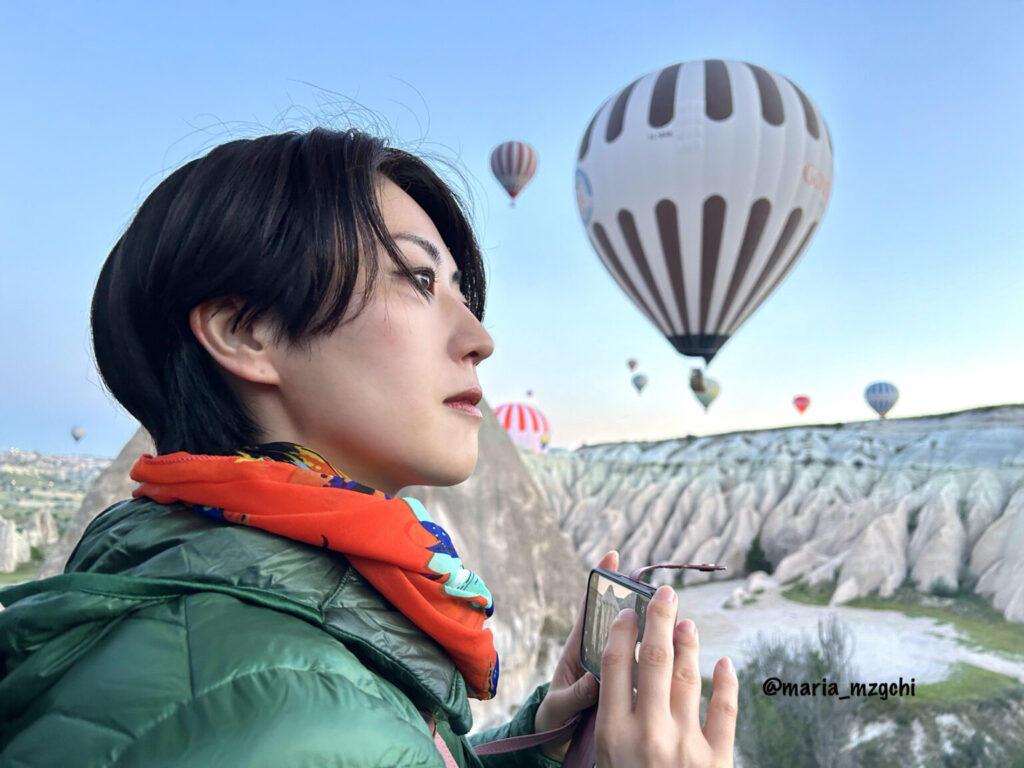
So you finally crossed off one of your bucket lists and visited Turkey.
When I actually landed in Cappadocia, it almost felt surreal that I was really there. Seeing the photos later on convinced me that the trip had been real. I was in Turkey, ate local food, spoke with the locals, and occasionally made sketches. The trip only lasted for a few days, but the experience has broadened my world greatly. It’s almost as if the entire experience will live on in my art for the rest of my life.
Could you elaborate on how you create your paintings after you visited Turkey? Do you try to recreate your image through photos and sketches?
When I visit, I make sketches and interview people, as well as gather research materials. I visit museums to look around and also take in the local history. In the end, it’s about being able to reconstruct the deep emotion I felt during my visit, during which I gradually see the picture forming in my mind.
So you absorb as much as you can through your experiences and local environment. Then, once you’re back in Japan, you ruminate and let it mature, allowing it to gradually take shape?
In a sense, it’s like panning for gold. Over time, you can turn your collection of gold, a metaphorical feeling of deep emotional connection, into a work of art.
I see, so each painting is full of essence.
The paintings may seem different from the actual scenery, but when I create a work of art, the painting takes the form of the images that remain within me from my experiences.
Do you usually combine those images with cats when you create your paintings?
The cats in my paintings are drawn in the image of cats that roam freely around the world. If the theme is a foreign venue, I’ll create the painting with the cat traveling around the world as its main character.
Do you project yourself as a small part of the cat?
Perhaps. The cat could also be a traveling partner, one that just exists in place, or a local cat. You can imagine the cat as your tour guide on a journey, showing you the world.
Do cats have a multifaceted essence? Can it be both subjective and objective, be in Japan and abroad, exist in the past, present and future?
The cats are mysterious beings that appear everywhere, even taking the place of the viewer’s perspective.
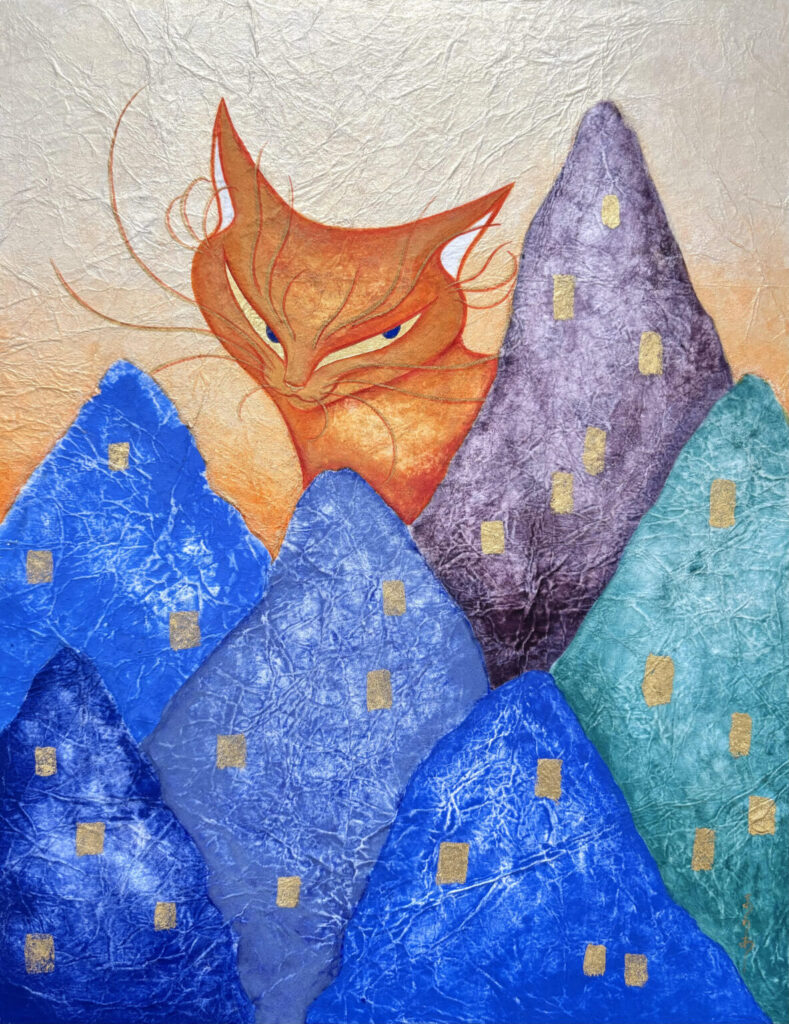
Inspired by her travels to Cappadocia, this is her first work after the trip. The rocky mountains are recreated in the image of colors of nature tinted by the sun, while the gold leaf squares scattered on the mountainside symbolize the signs of life of the people who once dug and lived in the mountainsides. The orange cat, an unusual choice of color for the artist, is an image of nature’s incarnation that brings forth nighttime.
Grasping the image before it escapes me
I understand that travel is an important source of inspiration for you. Do you have any other source of ideas?
There are many ways to draw inspiration from ideas, but since I mostly paint emotions, I sometimes put pen to paper about an emotion and think about how I can take that passage and turn it into a work of art, or a title for a piece. Occasionally, it comes to me in my sleep. Sometimes, there’s a fleeting image I want to capture and hastily sketch it in my bedside notebook, even if the room is dark. There are times when I write down words describing my dream, and other times when I make drawings from it. Words might be the only things that come to mind, and other times just colors. Whatever it is, if I don’t write it down on the spot, these fleeting images will melt away like snowflakes.
I don’t remember my dreams very well, but I know I have them often. I sometimes have dreams that are meaningful for creating my art, and it can be quite a challenge to see how much I can bring those memories back with me as I wake up.
While working on a painting, there might be an image that I’d like to paint. When I was a student, I never thought about the next piece and tried to put everything into the current piece I was working on. That often resulted in a jumbled mess. One day, I realized that I could just paint the image in another painting. If I wanted to paint something, I would simultaneously start painting it on the spot while working on another painting.
Almost as if you have to get your hands on the image and finish capturing it before the image escapes you?
Yes, that’s an apt description. I’m currently working on 5-6 paintings all at once. Sometimes there are more, but it’s difficult to work on too many paintings at the same time. So, I put the image down on paper, put it on the panel, and ask the sketch to give me more time.
I’m very busy all the time. I’ve never yet run out of ideas, and there are still so many things I want to draw that I haven’t been able to give shape to at all. I continue to wonder if I’ll be able to put them all down on paper before I die, with a steady stream of new ideas forming all the time.
You may need more than 120 years.
Yes, and that’s why I would like to live a long life.
Prepare beforehand, be mindful during, and reward myself after the exhibition
You have an upcoming exhibition. What are some things you focus on especially before and during the exhibition?
First and foremost, I do my best to paint the cat fitting to be the star of the venue. In other areas, I like to think about things like going out to eat my favorite pudding after the exhibition ends. I refrain from drinking alcohol for the duration of the exhibition to fully concentrate on it. I also take special care of my health, ensuring I get plenty of sleep.
Before an exhibition, most of my time is spent indoors painting for hours. If I suddenly go out for a week to participate in an exhibition, I know my body will pay for it. That’s why I make a habit of doing small exercises before exhibitions to loosen up my body, such as doing Pilates or going outside for short walks to unwind my mind and body. It’s all about health, isn’t it? I try to take care of my health as much as I can.
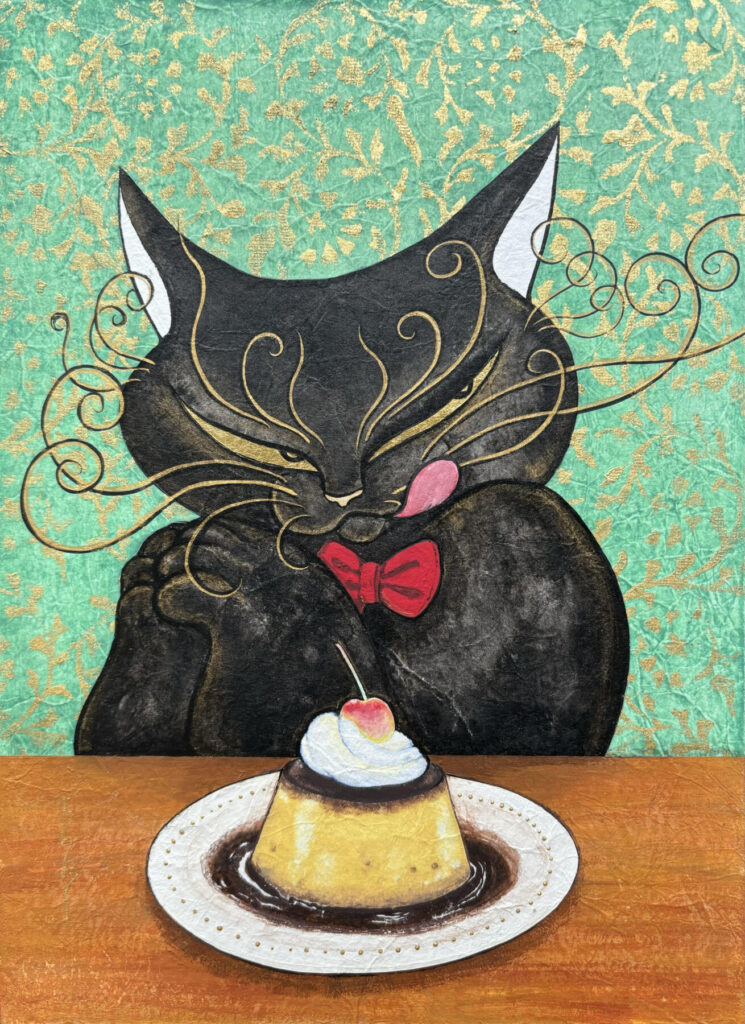
Perhaps the artist is anthropomorphizing the cat to express her excitement at seeing her favorite pudding.
Some artists stay up all night for two or three days before the exhibition.
One of the most important things is to make my pieces look their best in natural light, so I’ve decided to paint only during the hours when the sun is out. In the past, I had to finish my paintings at night to make the deadline, pulling all-nighters. More than once, I’ve regretted it because the colors looked completely different in natural light. Painting during the day is essential for my paintings, so I try to maintain a routine.
I noticed that you bring your lunches from home during the exhibitions.
That’s right, I bring a bento from home every day. My mother always makes one for me, and I’m incredibly grateful. I love her food more than anything else, and eating at home is the best. I love to eat at home so much that I don’t feel the desire to eat out at all.
I’d really like to sample it once! I also find your fashion, the ones you wear to your exhibitions, very unique.
I try to dress in line with the theme of my work. In my opinion, the artist is also part of the world in the exhibition venue, and I dress in a way that best complements the cats featured in the paintings. Oftentimes, the outfits that belonged to my late grandmother feel right for that role. I mix and match a combination of clothes from various eras, rather than opting for trendy things.
This one I have on is a dress that looks like a kimono at first glance. She was a very fashion-conscious grandmother, and we’re almost the same height, so I’m wearing it as is. Wearing it gives me inner strength; I have a deep connection and feel supported by my family, starting with my mother’s bento, my grandmother’s outfits, and my energetic cats.
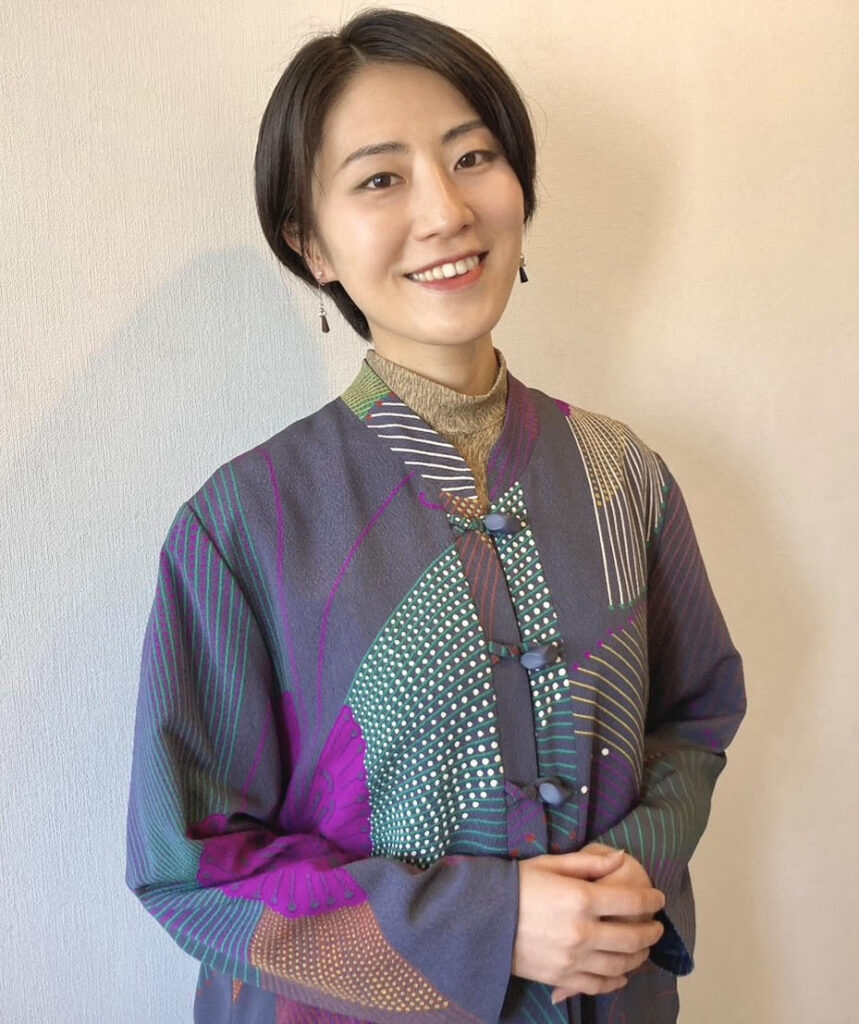
I hope that I can bridge the space between the paintings and the customers
During the exhibition, you’re there talking to visitors almost daily, from morning till the end. As an artist, what are your thoughts about talking with the visitors about your paintings?
As an artist, I think that one of the last things I can do for my artwork is to bridge the gap between the paintings and the customers by talking to them and describing the best things about my cats.
It’s impossible to tell the whole story, and I think it’s good for the viewers to imagine and create their own story of the paintings. Nevertheless, I hope I can provide them with a small detail or side story that will spark their imagination. I sincerely hope that my conversations will invite people to become interested in those paintings and build a bridge between them and those cats.
Additionally, since I’m mostly painting by myself indoors before the exhibition, I don’t get to talk to others much. It’s nice to have the chance to talk to a variety of people during the exhibition!
What do you think about those who say they don’t need any explanation because they can see the paintings and form their own thoughts?
I think that’s fine too. Eventually, I think it would be best if the customer feels an affection for the cats in the painting and cares for the piece enough to bring it home with them. At present, I’m not that well known, so I’m doing what I can to help bridge that gap between the customer and the cats.
I sincerely enjoy talking to people at the venue. I often have cat talks with the customers, and sometimes these conversations inspire me to create new artwork. Every experience is connected to creating art for me.
Do you love all of your paintings very much?
I adore them. It’s not that I’m comparing them to other paintings, but rather that I feel affection for my cats and my paintings while I’m working on them, and reflect on how wonderful they are. I give compliments to the cats while painting, telling them that they’re the coolest cats in the world and how adorable they are. I’ve always been fond of my paintings. It’s partly why I paint hoping that my paintings will have a long life.
You always say that you want your paintings to last a thousand years. Naturally, are you selective about the painting materials you use?
Absolutely. I want my paintings to last a long time, and thus use materials that won’t discolor over time. I try to experiment with different kinds of washi and other materials and continue to research in order to create new ways to express my art.
I hope my paintings will stay with people for a long time, and that I can leave behind the same deep emotion I felt when I saw Ito Jakuchu’s Fowls for future generations. I want to continue painting with the same excitement I felt when I first discovered his paintings.
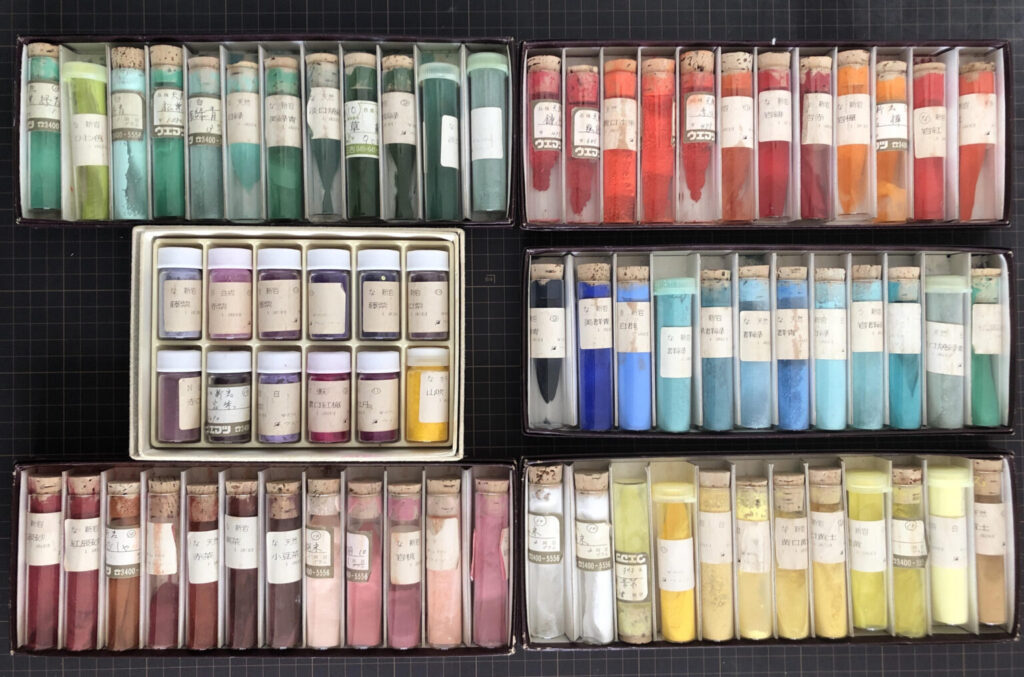
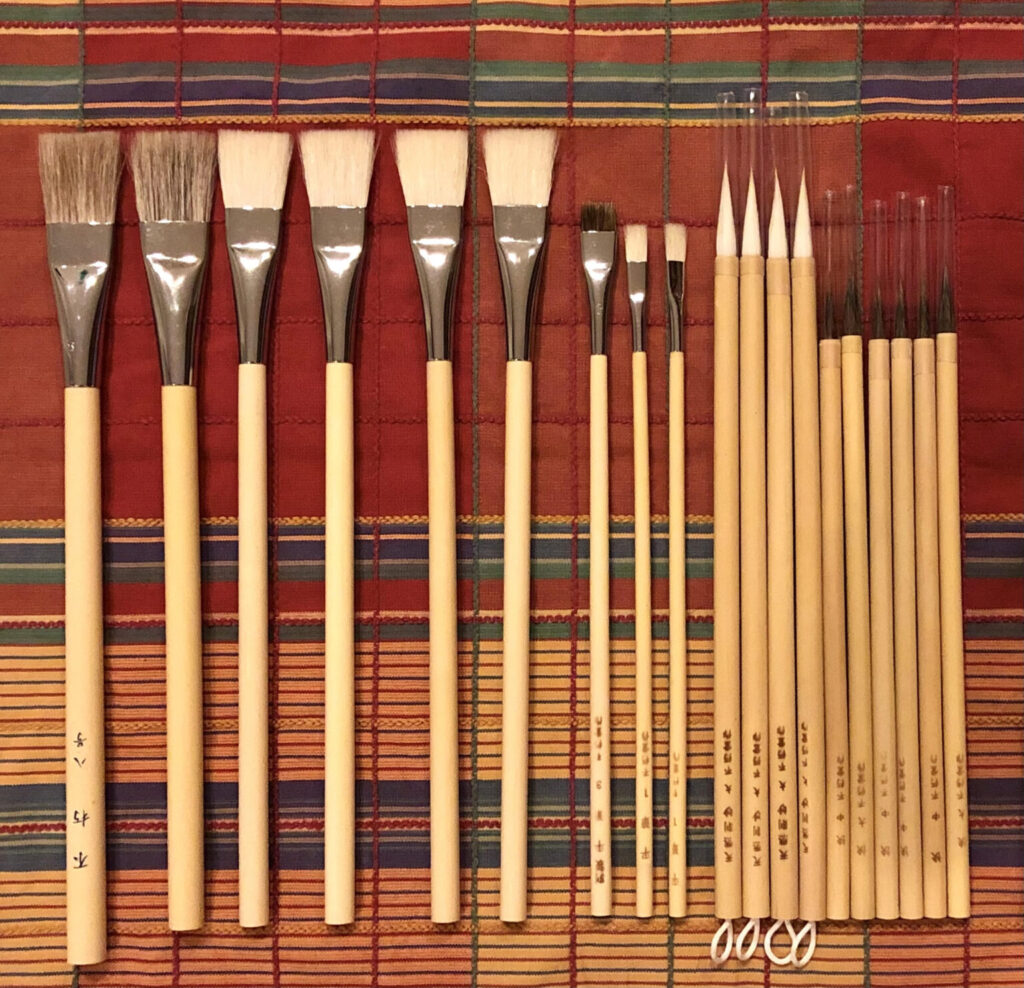
When your painting gets a new home, how would you like the customer to relate to the paintings?
All of my cats have their unique gaze, and are painted in a special way so as not to make eye contact with the viewer. It conveys to the viewer that the cats have no hostile intentions. I paint my cats as if they’re sharing their living space at home, rather than occupying the space as pets or paintings.
I also paint black cats. In Japan, black cats are known to exorcise evil, called Anko (bean paste) cats, and have long been cherished as cats that bring good luck. I send off my cats with the intention that they’ll do their job well to make their new home a happy place.
The guardian cat.
I occasionally receive thank-you letters from customers saying that they feel very protected when they hang the painting of the cat as their mamorigami (guardian deity). I’ve received letters like this from several customers, and I feel that my cats are doing their job.
Even the cat inside the painting moves at will
From the sound of it, it doesn’t sound like you’ve had a difficult time with your paintings. Have you experienced artist’s block?
I’ve always had a steady stream of ideas about things I want to draw, so I don’t think I’ve experienced much of a creative block so far.
However, I have experienced difficulties. I use a technique called tarashikomi to draw the cat before drawing the background. This method uses ink placed on wet washi, and the cat is drawn by using the shape of the ink that blurs onto the washi. I can generally predict to some extent how the ink will spread, but the ink has its own mind as to where it moves in the middle of the drawing, which sometimes results in a composition that’s entirely different from my initial plan. Sometimes, a cat that was supposed to be just standing still will have its hands out before you know it. This means I have to rework the background from the one I had in mind.
So, you have to paint along with the whims of the cat in the painting?
Usually, in Nihonga, both small and large sketches are drawn, copied onto a piece of paper, and then painted using pigments. In my case, after drawing an image, I immediately make a light rough sketch on washi and paint using sumi ink.
Previously, I used to go through the traditional time-consuming process of Nihonga painting very carefully but found that inspiration would sometimes have run away by that time. Cats are easily bored and won’t stay for your sake. My view might sound slightly intuitive, but for me, it works to paint the cat first, and then finish the background while the cat’s there.
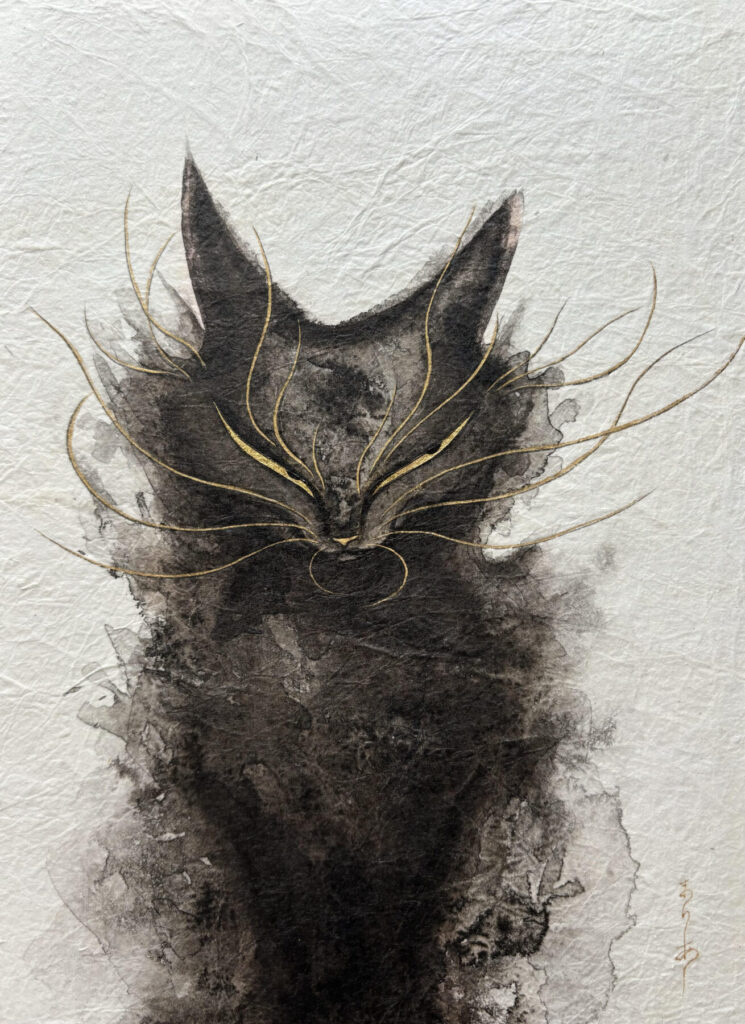
Tarashikomi is a technique favored by Tawaraya Sotatsu and later used by Rimpa school artists. The painting is intended to give the viewer a sense of the ink spreading and blotting out on washi.
Do you paint all your cats using the tarashikomi technique?
Yes, all of my cats are painted using the tarashikomi technique. The final outline is drawn tightly before it’s completed, but until then, the ink extends freely on the washi, as if the cat’s posing freely. I’m rarely able to draw something exactly as I want, but that’s also the interesting part of painting.
Having a deep love of your art is vital
What do you value most, or what do you think is most important as a painter right now?
I think the most important thing for me is having a deep love for my artwork. I put a lot of genuine love into my paintings, and paint with the hope that when the cat painting finds a new home, it will love and protect its new family and become a mamorigami (guardian deity) there.
What kind of activities do you hope to pursue in the future?
I believe that many people in the world need my paintings, and I would like to deliver them to them. For this purpose, I would like to exhibit my paintings overseas.
Like Fumiko Hori, I would like to see more of the world and create new paintings from such experiences. There’s a country I’m hoping to visit next year. I don’t know if I’ll be able to reflect that into my pieces right away, but I hope that’s something you can look forward to seeing more in my new works.
For the present, do you see cats as the best voice for your artistic expressions?
Yes, I think so. I’ve been painting on the theme of emotions with cats as a medium for a while now. I’d like to expand on that theme by using colors and patterns as motifs, as well as more abstract works. I already have an image in my mind. I would like to present these new kinds of pieces and expand the range and scope of my work. This might be different from what’s generally referred to as abstract art. What I have in mind is an expression of my emotion using colors and patterned motifs. I would like to paint more concrete works, instead of “Untitled” paintings.
I look forward to seeing how your paintings will continue to change as you age to 120. Thank you very much for your time today.
(Interviewed and written by Takashi Watari, Art Consultant)
Artist bio, awards and exhibitions

Maria Mizoguchi
Nihonga artist
Cats are the main motif of Maria Mizoguchi’s works, and she’s currently working on the “Lovable Sourpuss” series. Maria, who lives with cats and has a thorough knowledge of them, finds them to be honest and proud creatures, though often considered cynical by humans. Their seemingly distorted and identical figures and expressions are the result of thoughtful conception and sketching, and display a wide range of emotion in their anthropomorphized form. The artist states that she hopes to create works that will encourage people to continue to stand for their beliefs through her Lovable Sourpuss paintings. Perhaps that might be why her fanbase has spread beyond the boundary of cat lovers and gained over 1,400 Instagram followers.
The artist was first introduced to Nihonga when she encountered Ito Jakuchu’s Gunkeizu (Fowls) as a junior in high school. Since her university and graduate school days, she has been researching and studying Nihonga painting materials and techniques to create paintings that can be handed down to future generations. The cats painted with mineral pigments, sumi ink, gold leaf, and gold paint have been long loved by her customers.
1992 Born in Setagaya, Tokyo
2016 Mitsubishi Corporation Art Gate Program Scholarship Recipient
2017 Doctoral Candidate in Nihonga Research Field, Joshibi University, Graduate School of Arts and Design
2016 The 33rd (34th, 35th, 36th) Mitsubishi Corporation Art Gate Program, Honorable Mention
2017 The 4th Reorganized New Japan Art Exhibition “Nitten”, Honorable Mention (The National Art Center Tokyo)
2018 The 2nd SinNissyunten Exhibition, Honorable Mention (Tokyo Metropolitan Art Museum)
2020 WINE PROJECT 2020 The Republic of San Marino Winery “Peace Wine” wine label artist
2017 Group Exhibition, Fukuya Hatchobori Main Building, Hiroshima
2018 Group Exhibition, Isetan Urawa Store, Saitama
Group Exhibition, Fukuya Hatchobori Main Building, Hiroshima
Group Exhibition, Hanshin Umeda Main Building, Osaka
Shanghai Art Fair 2018, Shanghai
2019 Group Exhibition, Fukuya Hatchobori Main Building (Hiroshima)
Solo Exhibition “Maria Mizoguchi Nihonga Special Feature”, Isetan Shinjuku Main Building, Tokyo
Solo Exhibition “Maria Mizoguchi Nihonga Exhibition” Isetan Urawa store, Saitama
Osaka Art Festival, Hanshin Umeda Main Building, Osaka
2020 Art Safari Park, Isetan Shinjuku Main Building, Tokyo
Solo Exhibition “Maria Mizoguchi Nihonga Exhibition”, Isetan Urawa Store, Saitama
Group Exhibition, Fukuya Hatchobori Main Building, Hiroshima
Group Exhibition, Hanshin Umeda Main Building, Osaka
2021 “Mural Production” Higashi-ku Citizens Cultural Center, Children’s Room, Hiroshima
Duo Exhibition “Animal Paintings from the Golden Country”, Fukuya Hatchobori Main Building, Hiroshima
Solo Exhibition “Maria Mizoguchi Nihonga Exhibition”, Isetan Urawa Store, Saitama
Group Exhibition, Hanshin Umeda Main Building, Osaka
2022 Solo Exhibition “Maria Mizoguchi Nihonga Exhibition”, Hanshin Umeda Main Building, Osaka
Group Exhibition, Hanshin Umeda Main Building, Osaka
Solo Exhibition “Maria Mizoguchi Nihonga Exhibition”, Ginza Mitsukoshi Main Building, Tokyo
2023 “CAT PERSON” Tokyo Midtown Galleria Roppongi ISETAN SALONE, Tokyo
Duo Exhibition “Cat Festival”, Hanshin Umeda Main Building, Osaka
Solo Exhibition “Maria Mizoguchi Nihonga Exhibition”, Ginza Mitsukoshi Main Building, Tokyo
Solo Exhibition “Maria Mizoguchi Nihonga Exhibition”, Isetan Urawa Store, Saitama
Solo Exhibition “Maria Mizoguchi Nihonga Exhibition”, Fukuya Hatchobori Main Building, Hiroshima, November
2024 Solo Exhibition “Maria Mizoguchi Nihonga Exhibition”, Hanshin Umeda Main Building
Solo Exhibition “Maria Mizoguchi Nihonga Exhibition”, Ginza Mitsukoshi Main Building, Tokyo
Group Exhibition, Echoes of Art (Paying Homage to Hokusai), Ogaki Bookstore, Azabudai Hills, Tokyo
Maria Mizoguchi, Artist website
https://mizoguchi-maria.jimdofree.com/
Instagram
https://www.instagram.com/maria_mzgchi/
YouTube
https://m.youtube.com/channel/UCxDZFkE88fMar-P-0Db5GsQ
Description of work, Maria Mizoguchi, Fukumaneki (Beckoning Luck)

The traditional maneki-neko cat figurines are favored for their auspiciousness with their red-and-white colored form and charming expression, dressed in an inviting pose with their paws raised, beckoning customers and treasures.
In contrast, what kind of sense does this painting evoke? The dignified cat silhouette against a background of vivid and deep blue and a golden leaf circle is titled Fukumaneki (Beckoning Luck). It’s a far cry from the common maneki-neko (beckoning cat). Some wonder if this cat is angry when they see its astute eyes that don’t show even the slightest sign of flattery, but cat lovers insist this is what a normal cat’s expression is when it’s in a good mood.
Domestic cats that bring good fortune take pride in their work. While inviting good fortune with its paws, it also keeps an eye on the house to make sure there’s no room for evil to enter. Each of its eight left and right whiskers and brows curl outwards. The gold leaf circle against the deep blue background reminds the artist of the mid-autumn moon that shone in a large golden glow in the sky of Samarkand, giving her a lasting impression.
However, when looking back again at this black cat standing with a sense of mission, the golden circle resembles a halo. With the world in turmoil due to man-made and natural disasters, we can’t help but feel like praying to this cat for peace and safety, keeping evil at bay.
(Description by Takashi Watari, Art Consultant)
Details of Maria Mizoguchi’s Exhibition
Maria Mizoguchi Nihonga Exhibition
“New Year,Fuku Maneki(Beckoning Luck)”
Isetan Urawa Store, 6F Art Salon (Free Admission)
December 31 (Tue) – January 7 (Tue)
*December 31 (10:00 – 17:00)
*January 1st (Closed)
*January 2nd (10:00 – 18:00)
*January 3rd-6th (10:00 – 19:00)
*January 7th (10:00 – 17:00)
Please note the hours of operation during year-end and New Year’s holiday.
This is an exhibition for the whole family to enjoy, including works with auspicious themed maneki-neko (beckoning cat) and the year of the snake, a good way to welcome the New Year. Approximately 40 Nihonga paintings using traditional techniques will be on display. Please come and visit the “New Year, Fuku Maneki (Beckoning Luck)” exhibition!
Commemorative Event:
To celebrate 2025 (7th year of Reiwa), we will present an original Maria Mizoguchi card to the first seven customers who purchase the paintings.
